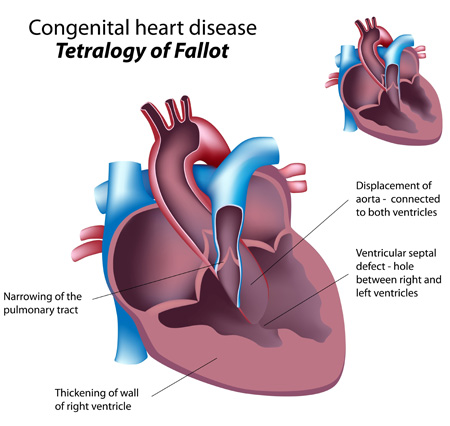Normal Heart

What is a Tetralogy Of Fallot?
This is a type of congenital heart disease meaning babies and children with Tetralogy of Fallot have the condition from birth. In fact Tetralogy Of Fallot can even be diagnosed before birth by antenatal scanning in some cases.Four abnormal findings are found in the heart:
- Pulmonary stenosis (narrowing of the tube which carries deoxygenated blood from the heart to the lungs).
- VSD (a ventricular septal defect) – a hole between the 2 lower pumping chambers of the heart.
- Overriding aorta. The aorta (the large blood vessel which normally carries red oxygenated blood around the body) is positioned over the hole(the VSD). This results in blue deoxygenated blood passing into the aorta, which then mixes with the red blood from the left pumping chamber (ventricle). Because of this mixing of blue and red blood the child’s oxygen levels are often below normal (cyanosis).
- Right ventricular hypertrophy. The right lower pumping chamber (right ventricle) must work harder than normal to pump blood through the narrowed pulmonary artery. Because of this increased demand, the right ventricle muscle wall thickens – this is known as right ventricular hypertrophy.

Symptoms
Some children will have no symptoms. A heart murmur may be noted or the baby may be noted to have reduced oxygen saturations with a bluish tinge to the lips and tongue.
Babies can have so called ‘Fallot’s spells’ when they can become profoundly blue or pale, scream differently to their usual cry and even lose consciousness. If this occurs at home, the baby should be taken immediately to hospital. Older children with untreated Fallot’s may squat and appear blue at times of spelling.
Those with only minor pulmonary valve narrowing, may become breathless, tire more easily, have slower weight gain with feeding difficulties and be more prone to respiratory infections.
Children who present later in life may be in the habit of squatting when they become tired.
Diagnosis
A clinical examination will usually reveal a heart murmur and a blue tinge to the mouth. Oxygen saturation testing may reveal reduced oxygen levels. An echocardiogram will make the diagnosis. An ECG and chest-X-ray will be performed.More detailed imaging with a CT scan, cardiac catheter or MRI is sometimes required.



Treatment
- Babies may be prescribed a beta blocker, in an oral liquid preparation, such as propranolol. This aims to prevent Fallot’s spells.
- If babies become very blue with spelling, when they are very young, or if the degree of pulmonary narrowing appears severe on medical imaging tests, then palliative procedures will be considered. These include :
- a keyhole cardiac catheter procedure called a balloon pulmonary angioplasty. A tube with a deflated balloon is passed into the body via a vein in the leg. The tube is passed into the heart to the narrowed pulmonary artery. The balloon is then inflated to stretch the narrowed area to widen it. Sometimes a metal stent is placed at the narrowed site to keep the are open.Further surgery will be required when the child is bigger.
- a palliative operation, called a BT shunt (a modified Blalock Taussig shunt). This operation is usually performed via an incision on the back of the child’s chest. A synthetic tube is surgically inserted to provide additional blood flow to the lungs. Further surgery will be required when the child is bigger.
- Open heart surgery on the cardiac bypass machine to repair the condition. A patch is placed on the hole and the narrowed section of the pulmonary artery is widened. With time the right ventricular hypertrophy disappears.
Dr Naqvi works with an excellent team of NICOR audited congenital cardiac surgeons and will refer your child to the one who is best for your child’s heart.
Prognosis
The outlook for children with Tetralogy Of Fallot is usually excellent. Some patients are left with a leak across the pulmonary artery. This may require further surgery later in life (usually between the teenage years and young adulthood). This may be open heart or via transcather keyhole placement of a Melody valve. These procedures also have excellent success rates.
Dr Naqvi has cared for many babies and children with Tetralogy Of Fallot and has followed them up until adulthood. She says “Having Tetralogy Of Fallot does not stop children doing well in sports or from having a happy full life. I know many who are in school teams and even competing at county level. I even know patients who have achieved 10 A stars at GCSE despite having a Fallot repair as a baby.”
There are also a number of successful athletes with Tetralogy Of Fallot including Australian cricketer Beau Casson. Shaun White is an inspirational 2 times Gold medallist Olympic snowboarder (net worth $40 million) who had 2 cardiac surgeries for Tetralogy Of Fallot before 1 year of age. You can see his interview with Larry King on CNN on You Tube where he discusses his condition and his career.

For more information about aortic stenosis please see the following links:





